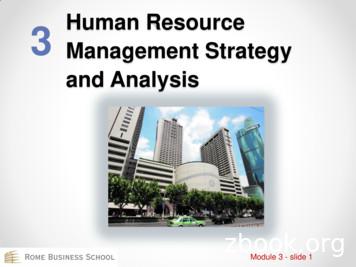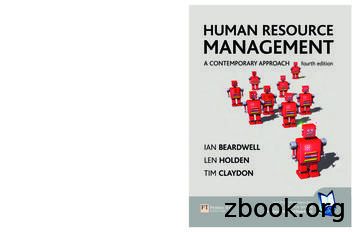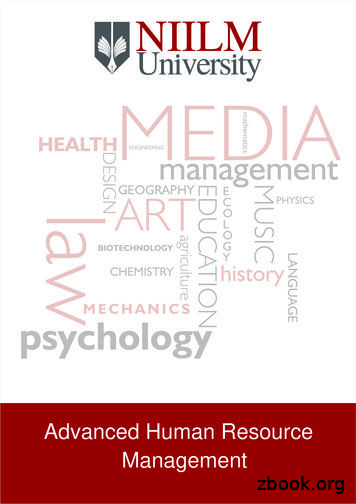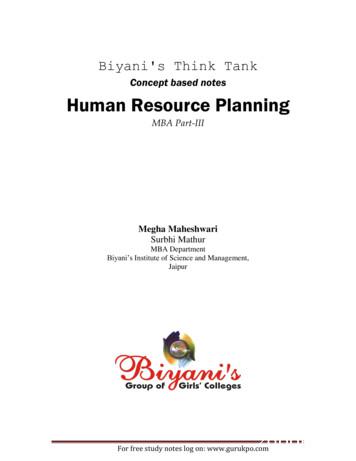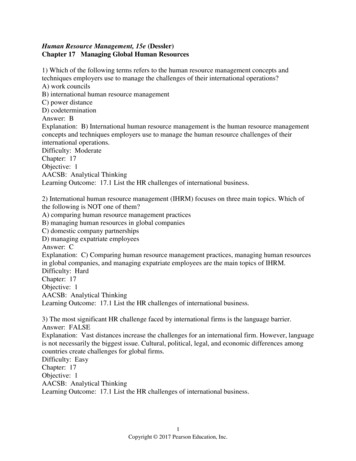3 Human Resource Management Strategy And Analysis
3Human ResourceManagement Strategyand AnalysisModule 3 - slide 1
Learning Objectives1. Explain why strategic planning isimportant to all managers.2. Explain with examples the steps inthe strategic planning process.3. List with examples the main generictypes of corporate strategies andcompetitive strategies.Module 3 - slide 2
Learning Objectives4. Define strategic human resourcemanagement and give an example ofstrategic human resource managementin practice.5. Briefly describe three importantstrategic human resource managementtools.6. Explain the importance of metrics formanaging human resources.Module 3 - slide 3
Why Strategic Planning isImportant to all ManagersModule 3 - slide 4
The strategic processAnalysisPlanningImplementationControlModule 3 - slide 5
Analytical toolsS.W.O.T. AnalysisModule 3 - slide 6
Analytical toolsPESTLE analysis PESTLE is an analytical tool whichconsiders external factors andhelps you to think about theirimpactsModule 3 - slide 7
The factors in PESTLE analysis P – Politicalo The current and potential influences from political pressures E - Economico The local, national and world economic impact S - Sociologicalo The ways in which changes in society affect the project T - Technologicalo How new and emerging technology affects our project / organization L - Legalo How local, national and global legislation affects the project E - Environmentalo Local, national and global environmental issuesModule 3 - slide 8
Companywide Strategic PlanningStrategic Planning A strategic plan is the company’s planfor how it will match its internalstrengths and weaknesses with externalopportunities and threats. A successful strategic plan helps ensurea competitive advantage.Module 3 - slide 9
Companywide Strategic PlanningStrategic PlanningStrategic planning is the process ofdeveloping and maintaining a strategicfit between the organization’s goals andcapabilities and its changing marketingopportunities.Module 3 - slide 10
Companywide StrategicPlanningCorporate LevelDefining thecompanymissionSettingcompanyobjectivesand goalsBusiness unit,product andmarket levelDesigningthe businessportfolioPlanningHRM andothefunctionalstrategiesModule 3 - slide 11
Companywide Strategic PlanningDefining a Market-Oriented Mission The mission statement isthe organization’spurpose, what it wants toaccomplish in the largerenvironment Market-oriented missionstatement defines thebusiness in terms ofsatisfying basic customerneedsWe help you organize the world’sinformation and make ituniversally accessible and useful.Module 3 - slide 12
Companywide Strategic PlanningSetting Company Objectives and GoalsObjectives should always be SMARTSpecificMeasurableAchievableRealistic and RelevantTime SpecificModule 3 - slide 13
How to write SMART ObjectivesDecide exactly what you expect tocreate, and how you will recognize itwhen it comes to be.Example: “Within the current year we wantto hire and train 35 new salespeople”Module 3 - slide 14
Companywide Strategic PlanningDesigning the Business PortfolioThe business portfolio is the collection ofbusinesses and products that make up thecompanyPortfolio analysis is a major activity in strategicplanning whereby management evaluates theproducts and businesses that make up thecompanyModule 3 - slide 15
Companywide Strategic PlanningAnalyzing the Current Business PortfolioIdentify key businesses (strategicbusiness units, or SBUs) that makeup the companyAssess the attractiveness of itsvarious SBUsDecide how much support eachSBU deservesModule 3 - slide 16
The Main Types StrategyModule 3 - slide 17
3 Types of tionalstrategyModule 3 - slide 18
Corporate Strategies ConcentrationDiversificationVertical integrationConsolidationGeographicModule 3 - slide 19
Corporate StrategiesThe corporate strategy question is, “How many and whatkind of businesses should we be in?” With a concentration (single business) corporatestrategy, the company offers one product or product line,usually in one market. A diversification corporate strategy implies that the firmwill expand by adding new product lines.Module 3 - slide 20
Corporate Strategies A vertical integration strategy means the firm expandsby, perhaps, producing its own raw materials, or sellingits products directly to consumers. A consolidation strategy means the company reducesits size. With geographic expansion, the company grows byentering new territorial markets.Module 3 - slide 21
Competitive Strategies Cost leadership Differentiation FocusModule 3 - slide 22
Competitive StrategiesA competitive strategy identifies how to build and strengthenthe business’s long-term competitive position in themarketplace. Cost leadership means becoming the low-cost leader inan industry. In a differentiation strategy, the firm seeks to be uniquein its industry along dimensions that are widely valued bybuyers. Focusers carve out a market niche (like Porsche).Module 3 - slide 23
Defining Strategic HumanResource Management withan Example of StrategicHuman ResourceManagement in PracticeModule 3 - slide 24
Strategic Human ResourceManagement Defining strategichuman resourcemanagement Human resourcestrategies andpoliciesModule 3 - slide 25
HRM Functional StrategyStrategic GoalsEmployee need, behaviourand skillsHR policies and practicesModule 3 - slide 26
Goal-Setting and thePlanning Process The hierarchy ofgoals StrategicplanningModule 3 - slide 27
ExampleModule 3 - slide 28
Management Roles inStrategic Planning Top Managers’ Role in StrategicPlanning Departmental Managers’ StrategicPlanning Roleso Deviseo Supporto ExecutionModule 3 - slide 29
Develop a strategic plan Analysis (P.E.S.T.E.L./S.W.O.T.)Mission statementGoals (SMART!)Corporate Strategy (concentrat.; diversific.,vertical integrat., consolidat., geographicexpans.) Competitive strategy (cost leadership,differentiat., focus) Functional strategy for HRM (goals, hiring,behaviour and skills, policies and practices)Module 3 - slide 30
Three Important StrategicHuman ResourceManagement ToolsModule 3 - slide 31
Strategic Human ResourceManagement Tools Strategy map The HR scorecard Digital dashboardsModule 3 - slide 32
Why Metrics are Essential forManaging Human ResourcesModule 3 - slide 33
HR Metrics andBenchmarking HR metricso Types of metrics BenchmarkingModule 3 - slide 34
Measuring Effectiveness Using HRMetrics HR Metrics Specific measures asHR performance indicators.o Demonstrate HR’s value and track its performance. Characteristics of good HR metrics:ooooooAccuracy.Linked to strategic and operational objectives.Clear calculations.Meet information needs.Can be compared internally and externallyCan be used to drive HR management effortsModule 3 - slide 35
Examples of Strategic and Operational HR MetricsStrategicOperational Revenue generated per FTE Annual turnover rate Net income before taxes perFTE Benefits costs as percentage ofpayroll Ratio of managers to nonmanagers Training expenditures per FTE Labor costs as percentage oftotal operating costs Workers’ compensation costs perFTE ROI of human capitalexpenditures Number of applicants peropening HR department expenses aspercentage of totalexpenses Absenteeism by employeelevel/department Average time to fill openings Payroll/benefits costs aspercentage of revenuesNote: FTE equals one employee working full-time one year.Module 3 - slide 36
Measures of Strategic HREffectiveness Return on Investment (ROI)o Calculation showing the value ofexpenditures for HR activities.CROI A BA Operating costs for a new or enhance system for the time periodB One-time cost of acquisition and implementationC Value of gains from productivity improvements for the periodModule 3 - slide 37
Metrics Calculator /pages/default.aspxModule 3 - slide 38
Strategy and StrategyBased Metrics Workforce/talent analyticsData miningHR auditsEvidence-based HRo The scientific method Why should a manager be scientific?Module 3 - slide 39
High-performance WorkSystems High-performancehuman resourcepolicies andpracticesModule 3 - slide 40
Define strategic human resource management and give an example of strategic human resource management in practice. 5. Briefly describe three important strategic human resource management tools. 6. Explain the importance of
Human Resource Management Human Resource Policy QUADRANT-I Module 4: Human Resource Policy 1. Learning Outcome 2. Definition 3. Employee understanding on HR Policy 4. Benefits of policy 5. Specific Personal policies 6. Responsibility for policy making 7. Formulation of Human Resource Policy 8. Principles 9. Procedures 10. Programs 11. Summary 1.
Human Resource Management Question Answer Bank MBA-203 Q.1 What is Human Resource Management Human Resource Management is a process, which consists of four main activities, namely, acquisition, development, motivation, as well as maintenance of human resources. Scott, Clothier and Spriegel have defined Human Resource Management as that
Human resource management: the state of the debate 24 Summary 27 Activity 28 References and further reading 29 2 Strategic human resource management Nicky Golding 32 Objectives 32 Introduction to strategic human resource management 32 Understanding the business context 34 Approaches to the strategy-making pr
1.1.2 Evolution of Human Resource Management 1.1.3 Human Resource Management: Nature 1.1.4 Human Resource Management: Scope 1.1.5 Human Resource Management: Objectives 1.2 Functions of HRM 1.3 Growing Importance of HRM Functions 1.3.1 Factors Contributing to the Growing Importance of HRM 1.4 Concepts and Essential of Management
Ans Human resource planning can be defined as the process of identifying the number of people required by an organization in terms of quantity and quality. All human resource management activities start with human resource planning. So we can say that human resource planning is the principle/primary activity of human resource management.
human resource functions while keeping them satisfied in their work. It covers a wide range of chapters on human resource management such as human resource functions, performance management and human resource development and empowerment. This module serves the purpose of a resource handbook for carrying out training on Human Resource Management
B) international human resource management C) power distance D) codetermination Answer: B Explanation: B) International human resource management is the human resource management concepts and techniques employers use to manage the human resource challenges of their international
Unit-V Generic competitive strategy:- Generic vs. competitive strategy, the five generic competitive strategy, competitive marketing strategy option, offensive vs. defensive strategy, Corporate strategy:- Concept of corporate strategy , offensive strategy, defensive strategy, scope and significance of corporate strategy
